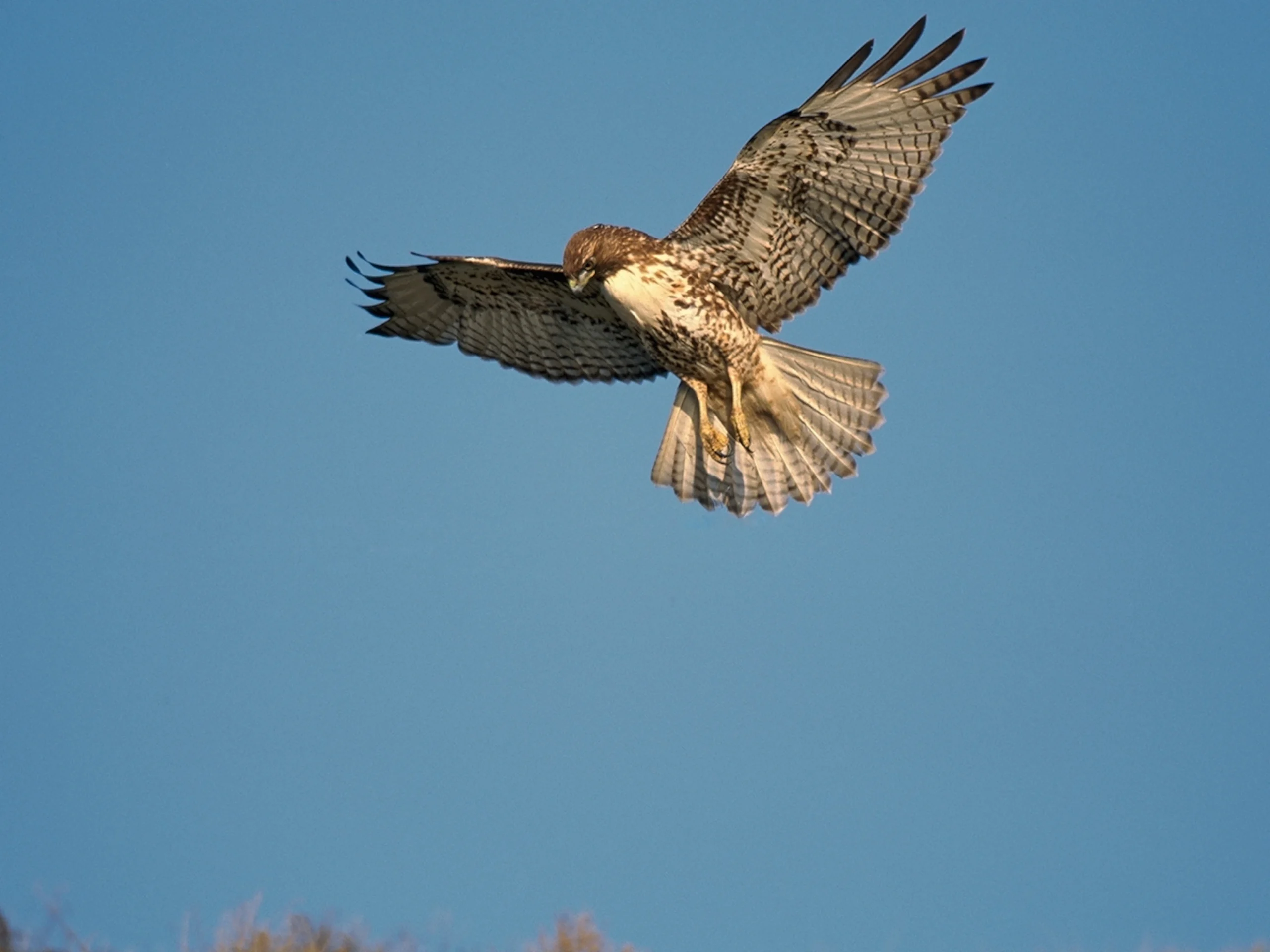From their high-plaintive whistle to mighty wings, hawks are interesting. These birds are naturally rare, so consider yourself lucky if you have the chance to spot them in action.
"How lucky?", you think?
There are more than 270 hawk species, but only a few are in South Carolina.
Read on and find out some of the most common types of hawks in South Carolina. Whether you want to attract them to your backyard or photograph these raptors with their prey, proper identification is crucial.
The Most Common Hawks of South Carolina
With vast forests and miles of coastlines, South Carolina is an avian paradise. It is home to over 480 species of birds. Nonetheless, only a few hawks can be seen roaming The Palmetto State, including those I will talk about below:
1. Red-Tailed Hawk
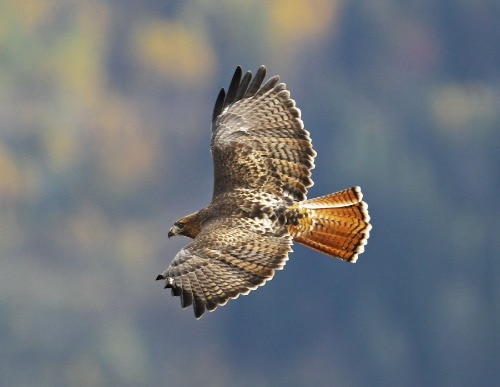
Weighing two to four pounds, the red tailed hawk is the largest hawk. It is also the most common amongst South Carolina hawks.
The red-tailed hawk is known for its broad and bulky wings, allowing the bird to soar effortlessly. It is often found on tall perches, highways, and open spaces.
The most recognizable characteristic of this hawk is its red tail, which is also where it got its name. The tails of females are often larger than males.
As for its body, it is a rich brown on the top and pale underneath. The belly has under-streaks while the underside of the wing has a dark bar between its shoulder and wrist.
Up to 90% of a red-tailed hawk’s diet includes small rodents. It swoops down as soon as it spots its prey, which it can see even if it is 100 feet above. That is roughly equal to ten floors, which proves that its eyes are up to eight times more powerful than that of humans.
In South Carolina, the nesting season of red-tailed hawks is from late February to March. Nonetheless, these birds do not begin breeding until they reach their third year.
Keep an open ear, and it is quick to detect the presence of red-tailed hawks around the area. As it soars, it has a hoarse scream, which lasts two to three seconds.
2. Cooper’s Hawk
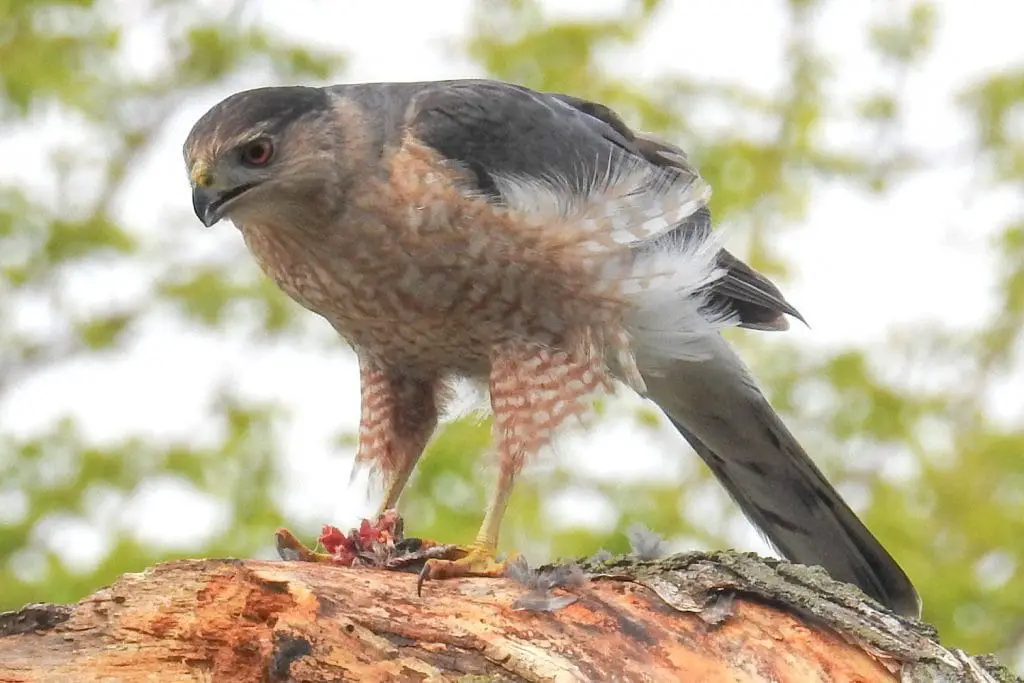
Come winter in South Carolina, it is common to see a cooper’s hawk soaring high in the sky. It keeps its face forward even if it is flying at high speed, which makes it easy for the bird to spot its prey.
As it hunts and flies, the male cooper hawk raises its wings. It maintains a wide arc as it soars while flapping its wings in a slow rhythm.
The cooper’s hawk has a length of 14.6 to 17.7 inches and weighs 7.8 to 24 ounces. Meanwhile, the wingspan ranges from 24.4 to 35.4 inches.
Make it easier to identify a cooper’s hawk by knowing its colors.
Most adults will be steel-blue on the top with dark and thick bands on its tail. Underneath its body, you will find warm red bars. Its upper breast, on the other hand, has brown streaks.
While it is most common to see these raptors on the edges of forests and riparian woodlands, it is also possible to attract them to a backyard. Add a birdfeeder and there is a high chance that these birds will soon be on your property.
3. Sharp-Shinned Hawk
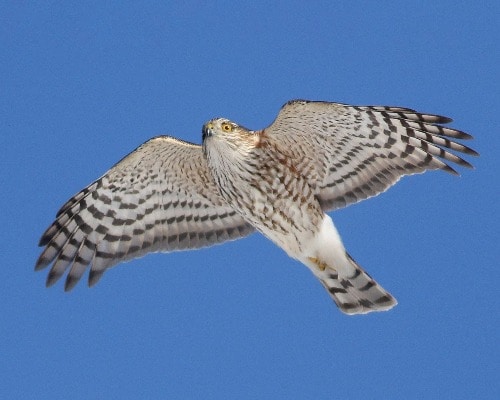
With an average length of 9.4 to 13.4 inches and weight of 3.1 to 7.7 ounces, the sharp-shinned hawk is the smallest amongst hawks South Carolina state has.
Also known as sharpies, these hawks often visit backyard feeders in the winter. However, they do not feed on sunflower and millet. Instead, they often prey on songbirds. They are strictly bird-eaters, but they prefer smaller species, including quail and dove.
When they are perched, a sharp shinned hawk has a short wing, long tail, and small head.
Meanwhile, when it is flying, you will notice its rounded and short wings that make it stocky with a slim but long tail.
The plumage differs depending on the gender on the age of the hawk. Juveniles have reddish-brown streaks below, brown above, and have yellow eyes. On the other hand, adults are white below with a black head, narrow, white-tipped tail, and the eye color changes from orange to dark red as the bird ages.
Sharpies are a sight to behold when they are flying. They are highly maneuverable and buoyant. They can make abrupt turns. However, in high winds, these birds can be unstable.
4. Northern Harrier
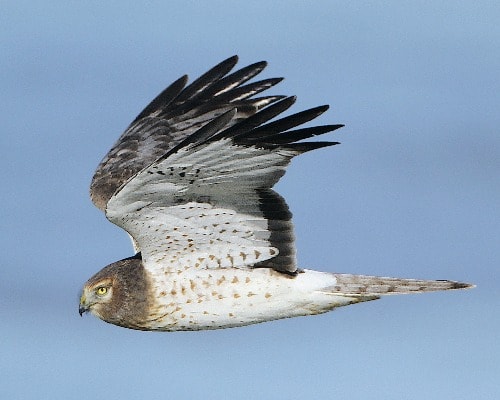
Also called marsh hawk, the northern harrier is a medium-sized and slender raptor with long, broad wings and a rounded tail.
Northern harriers fly low when they are hunting. They hover low on the ground, going back and forth as they search for their next prey. It watches and listens closely until it spots small animals. They often hunt on wetlands and grasslands, among other places with low vegetation.
Unsure if it is a northern harrier you are seeing? Look at its belly, which should be white. It also has small brown patches on its feathers across the plumage and belly. Their wings, meanwhile, are covered by pale grey feathers.
Another easy way to identify northern harriers is on their wings. They are dihedral when they are flying, providing the wings with a V shape.
While you will most often see these raptors in South Carolina in the winter, there are also possible sightings outside their breeding season. They have been spotted in almost all areas of the state, but they are most common in the eastern part of South Carolina.
5. Broad-Winged Hawk
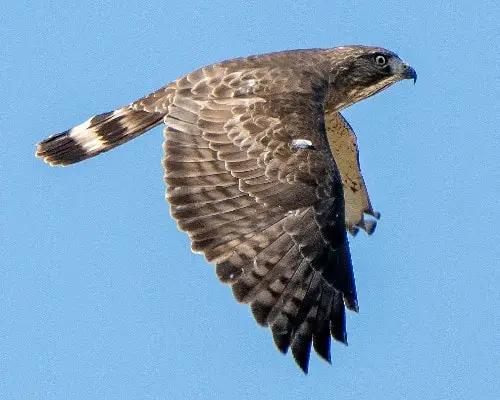
As their name implies, these hawks are known for their wide and broad wings, which can span 31 to 40 inches. Despite having large wings, it is a compact raptor.
It is common for these hawks to be found in South Carolina in the summer, although they are seldom spotted since they prefer hiding in the deep woods. Come winter, the broad winged hawk migration brings a high concentration of these birds in Central and South America.
During their migration, it is estimated that these birds travel up to 4,000 miles one way. They will complete this trip two times annually as they return after winter.
The best way to see these birds is during their migration. They soar in thousands, which is an awe-inspiring sight for those who are lucky enough to witness them leaving.
What makes these migrating hawks more majestic is when you hear their high-pitched whistle, which can last two to four seconds.
Like most hawks in SC, broad winged hawks are known for being perch and pounce species. Meaning, they often sit high to find their prey, and once they spot it, they quickly swoop down. It is rare that they are hunting when they are flying.
6. Red-Shouldered Hawk
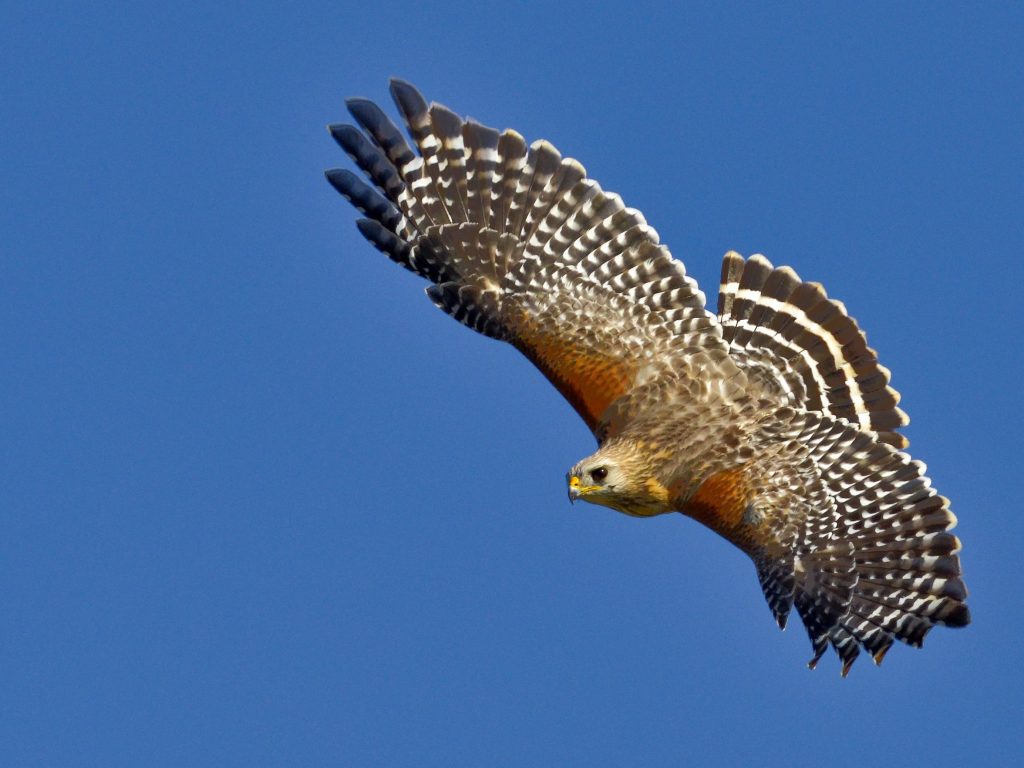
One of the most picturesque hawks of SC, these raptors are stout and compact with broad and pointed wings that complement a short tail.
On average, a red shouldered hawk has a length of 13 to 17 inches, a weight of 15 to 17 ounces, and a wingspan of 2.8 to three inches.
It is a part of the Accipitridae family, which is a group of 224 species of hawks, vultures, and eagles.
During the breeding season, it is almost impossible to detect these SC hawks. They are secretive and territorial. They circle the canopy where they built their nest to defend it from attackers.
The red-shouldered hawk is also known for its unique characteristic during courtship. You will see them flying together and rolling on their backs. They will also be flying upside down as they move short distances.
Another unique characteristic of this hawk in South Carolina is that you will hear the birds before seeing them. It has a conspicuous whistle, which is clearest in the spring. This is reminiscent of the sound of blue jays.
Like many of the hawks of South Carolina, it feeds mostly on small mammals. It also likes snakes and lizards when they are available.
Fun Fact: Did you know that hawks sometimes get interchanged with falcons! Learn to distinguish one from the other by reading our article on falcon vs hawk!
Watch This!
Frequently Asked Questions
Are hawks common in South Carolina?
Hawks are uncommon in South Carolina state. Sighting these raptors is a rare occurrence, so consider yourself lucky if you find one, especially if you spot it in your backyard. Among others, the most common hawk you will find in the state is a red-tailed hawk.
Where can you find hawks in South Carolina?
If you want to see small hawks in the Palmetto State, such as the cooper’s hawk and sharp-shinned hawk, then visit many of the state’s woodlands. On the other hand, for sightings of larger species, head to high ridges, open grasslands, and marshes.
Conclusion
While they may not be as common as wrens, chickadees, and woodpeckers in The Palmetto State, there are many opportunities for sighting hawks in SC. Whether it is in the forest or your backyard, you can spot the mighty and ravenous hawks of South Carolina.
Are there other hawks you have spotted in South Carolina? Share it in the comments below!

